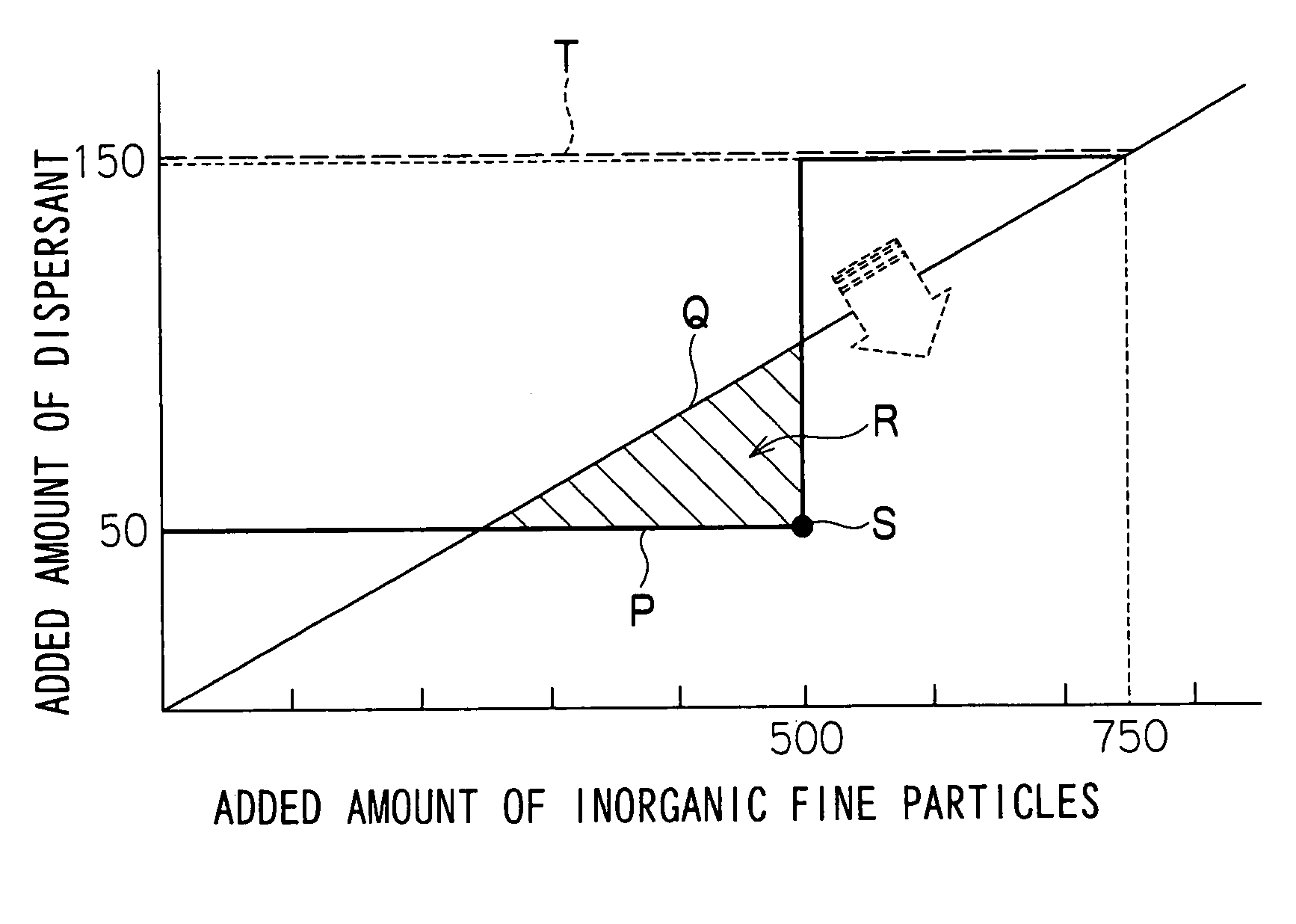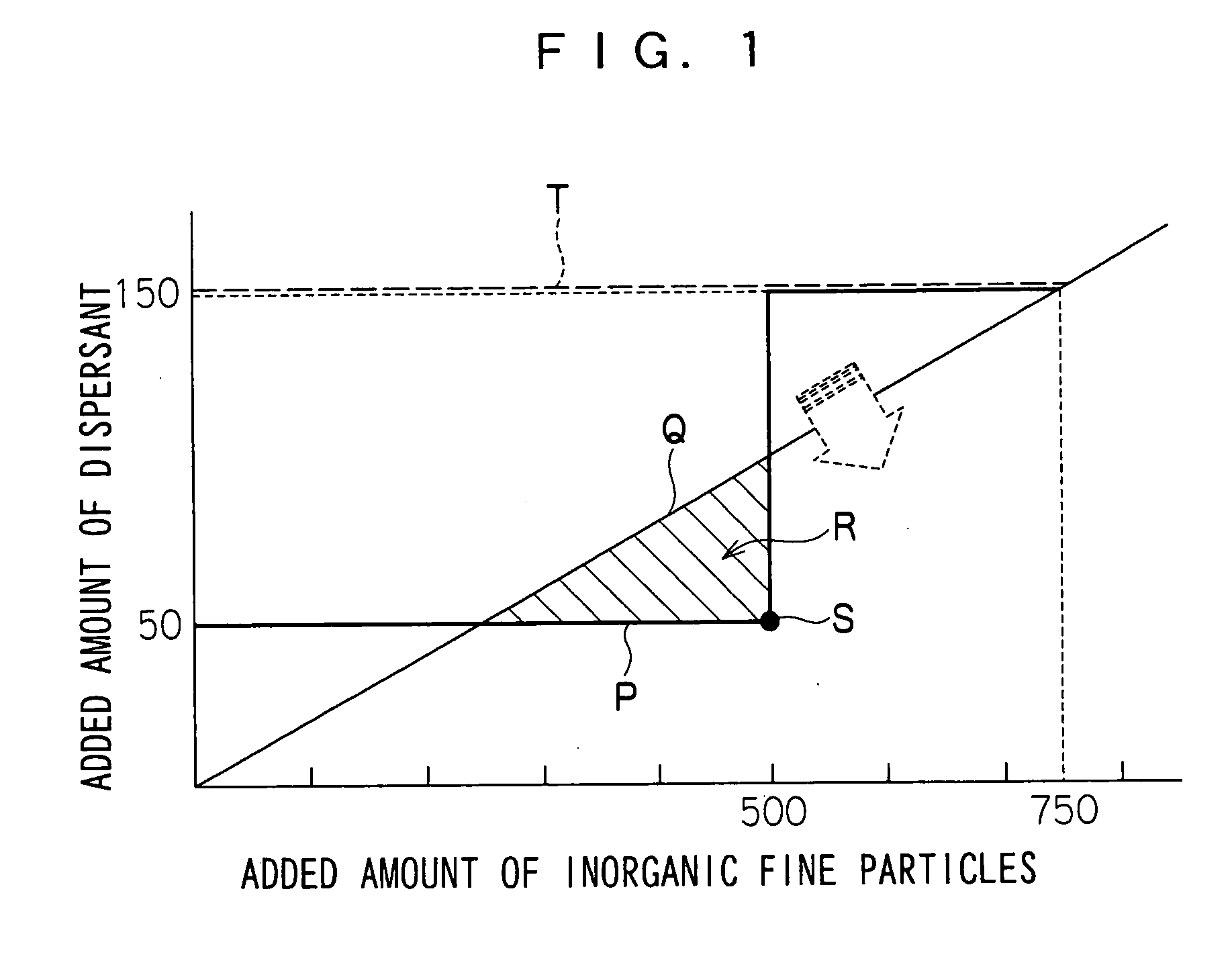Inorganic fine particle dispersion and manufacturing method thereof as well as image-recording material
a technology of inorganic fine particles and dispersion methods, which is applied in the field of inorganic fine particle dispersion and manufacturing methods thereof, and image-recording materials, can solve the problems of high energy consumption, energy saving and cost reduction, and inefficiency in production energy, and achieve low energy consumption, low viscosity, and high viscosity.
- Summary
- Abstract
- Description
- Claims
- Application Information
AI Technical Summary
Benefits of technology
Problems solved by technology
Method used
Image
Examples
example 1
Preparation of Silica Dispersion
[0306] The following components were mixed as described below to prepare a silica dispersion of the invention.
[0307] To a stainless pot having an inner diameter of 26 cm were added (1) ion exchange water and (2) boric acid, and this was stirred by a dissolver (blade diameter: 6 cm) at the number of revolutions of 1500 rpm until uniformly dissolved; thereafter, to this was added (3) Chemistat 7005 the amount of which corresponded to ⅓ of the total amount to be finally added and mixed at the number of revolutions of 3500 rpm, and to this was uniformly added (4) Reolosil QS-30 the amount of which corresponded to ⅔ of the total amount to be finally added in 5 minutes. At this time, the ratio Dt / It between the added amount Dt of (3) and the added amount of It (4) was 0.1.
[0308] Thereafter, to this was further added (5) unused Chemistat 7005 the amount of which corresponded to ⅔ of the total amount to be finally added, and to this was uniformly added (6...
example 2
[0320] The same processes as those of Example 1 were carried out except that, in “preparation of silica dispersion” of Example 1, the added amounts of the silica fine particles and the dispersant were changed so that the ratio Dt / It between the added amount Dt of (3) Chemistat 7005 and the added amount It of (4) Reolosil QS-30 was set to 0.15; thus, a silica dispersion was prepared, and this was evaluated in the same manner as described earlier, and an ink-receiving layer coating solution was prepared and an ink-jet recording sheet was formed. The results of measurements and evaluation are shown in Table 1.
Preparation of Silica Dispersion
[0321] To a stainless pot having an inner diameter of 26 cm were added (1) ion exchange water and (2) boric acid, and this was stirred by a dissolver (blade diameter: 6 cm) at the number of revolutions of 1500 rpm until uniformly dissolved; thereafter, to this was added (3) Chemistat 7005 the amount of which corresponded to ½ of the total amount ...
example 3
[0323] After a dispersant mixed solution as shown below had been prepared, the same processes as those of Example 1 were carried out except that, in “preparation of silica dispersion” of Example 1, the added amounts of the silica fine particles and the dispersant were adjusted by using the dispersant mixed solution so that the ratio Dt / It was set to 0.1; thus, a silica dispersion was prepared, and this was evaluated in the same manner as described earlier, and an ink-receiving layer coating solution was prepared and an inkjet recording sheet was formed. The results of measurements and evaluation are shown in Table 1.
Preparation of Dispersant Mixed Solution
[0324] Chemistat 7005 (40% aqueous solution; acryl-based cationic polymer; manufactured by Sanyo Chemical Industries, Ltd.)(525.00 g) and Zircosole ZA-30 (zirconium ammonium carbonate (water-soluble metal salt); manufactured by Daiichi Kigenso Kagaku Kogyo Co., Ltd.)(164.00 g) were mixed to prepare a dispersant mixed solution.
...
PUM
| Property | Measurement | Unit |
|---|---|---|
| particle size | aaaaa | aaaaa |
| particle size | aaaaa | aaaaa |
| particle size | aaaaa | aaaaa |
Abstract
Description
Claims
Application Information
 Login to View More
Login to View More - R&D
- Intellectual Property
- Life Sciences
- Materials
- Tech Scout
- Unparalleled Data Quality
- Higher Quality Content
- 60% Fewer Hallucinations
Browse by: Latest US Patents, China's latest patents, Technical Efficacy Thesaurus, Application Domain, Technology Topic, Popular Technical Reports.
© 2025 PatSnap. All rights reserved.Legal|Privacy policy|Modern Slavery Act Transparency Statement|Sitemap|About US| Contact US: help@patsnap.com


